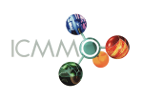Chimie Inorganique
Spin transition nanomaterials and molecular switching on surfaces
Marie-Laure Boillot (Research Dir.), Eric Rivière (Research Engineer, 10%)
PhD student : Arthur Tauzin
The research program targets spin-transition molecular magnetic materials whose properties can be manipulated by an external stimulus (for instance light, temperature and electric field). We design, synthesize and study these important materials for applications (sensors, information storage, electronics and molecular spintronics) with the objective of controlling the processes (switching, bistability of electronic states) at reduced scales of length and involving interfaces with the environment. This work is done with physicists and theoreticians to achieve a better understanding of mechanisms and to develop innovative systems.
- Axis 1 - Spin crossover nanomaterials
- Axis 2 - Mechnism and dynamic of the spin transition
- Axis 3 - Molecular switching on surfaces
Axis 1 - Spin crossover nanomaterials
Bistable spin-transition microparticles : Influence of the surrounding medium
The study of the relationship between the cooperativity of the spin transition and the particle size shows general trends but a few puzzling observations remain unclear. The difficulty arises from the combination of size effects with other factors including the particle surface and its interaction with the surrounding environment. First, we observed that the embedding in polymers, molecular liquids or glasses of microcrystals characterized by an abrupt transition was non-innocent. The transition curves are less cooperative and shift towards lower temperature, or give rise to thermal hysteresis. The magnetic study of these cycles (coll. E. Enachescu, Univ. Iasi, Romania) demonstrated that the hysteresis loop did not result from cooperativity but from (i) particle-matrix elastic interactions (b) that were modeled by negative variable pressure effects, (ii) their cutting off (c) – restoration (a) according to the change of volume driven by the spin transition and the glass-liquid transition. At low temperature, the particle environment also influences the spin switching induced by light and the kinetics of the LIESST relaxation, observation also modeled with a variable pressure effect. The matrix being active, the question to be studied now concerns the combined effects of interface, matrix and confinement taking place in the case of spin-transition nano-objects.
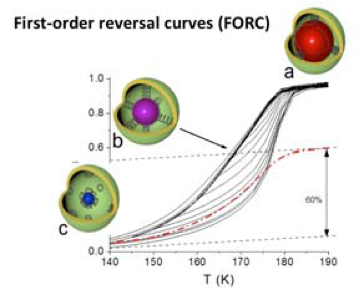
First-Order Reversal Curves (FORC) analysis of the hysteresis loop revealing a matrix effect rationalized with a combination of a variable negative pressure effect and the switching on/cutting off of elastic interaction
Matrix-assisted relaxation in Fe(phen)2(NCS)2 spin-crossover microparticles, experimental and theoretical investigations. C. Enachescu, R.Tanasa, A. Stancu, A. Tissot, J. Laisneay, M-L. Boillot (2016) App. Phys. Lett. 109, 031908
Hysteretic behavior of Fe(phen)2(NCS)2 spin-transition microparticles vs. the environment: A huge reversible component resolved by first order reversal curves. R. Tanasa, J. Laisney, A. Stancu, M-L. Boillot, C. Enachescu (2014) Appl. Phys. Lett. 104, 031909
Spin transition thin films formed by sublimation : Size reduction effect on the bistability
The effect of dimension on the physical properties of spin transition materials have been studied with thin films formed by molecular sublimation. The films, with a thickness of 130 nm and more, exhibit spin transitions with thermal hysteresis of 17 to 43 K-width depending on the increasing size of the crystallites constituting the films, transitions which are incomplete. A combination of structural, magnetic and optical measurements shows the formation of a metastable high-spin polymorph which co-crystallizes with the previously known spin-transition polymorph. By a thermal annealing of the film, this first polymorph was completely converted into the thermodynamically stable form, characterized by the spin transition with hysteresis. The phase transition process which here improves the material crystallinity makes it possible to control the opening of a remarkable hysteresis of 19 K-width in the case of the 130 nm-thick film.
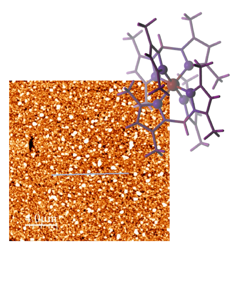
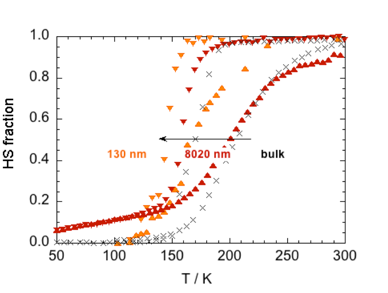
AFM image of the Fe(HB(Me2-pz)3)2 130 nm-thick film and spin-crossover curves of the 130 nm- and the 8020 nm-thick films compared to the bulk powder
The disentangling of hysteretic spin transition, polymorphism and metastability in bistable thin films formed by sublimation of bis(scorpionate) Fe(II) molecules. O. Iasco, M-L. Boillot, A. Bellec, R. Guillot, E. Rivière, S. Mazerat, S. Nowak, D. Morineau, A. Brosseau, F. Miserque, V. Repain, T. Mallah (2017) J. Mater. Chem. C 5, 11067-11075
Axis 2 - Mechanism and dynamic of the spin transition
Spin transition nanoparticles : elastic cooperativity in the out-of-equilibrium switching induced by an ultra-short laser pulse
One challenge in materials science is to control the cooperative phase transformation occurring in solids on ultra-short time scales. Bistable spin-transition materials that may be switched with light according to the LIESST effect are good candidates for this mechanistic and dynamical study done in collaboration with physicists (E. Collet, IPR, Univ. Rennes) and theoreticians (C. Enachescu, Iasi Univ., Romania). This phenomenon takes place via the coupling between the electronic (spin multiplicity) and structural (bonds, molecular volume) change at the origin of cooperativity. The simultaneous excitation of a large number of molecules within a spin-transition material requires a femtosecond optical technique and nanocrystals. It thus generates an elastic wave capable of self-amplifying the ultra-fast photo-switching of the material. This elastically-driven cooperativity triggered by a light pulse leads to an efficient route towards the generation and stabilization of photoinduced phases in volume-changing materials.
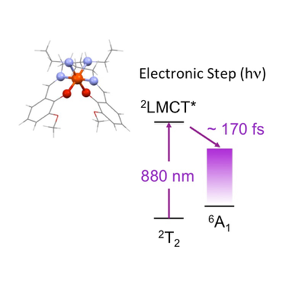
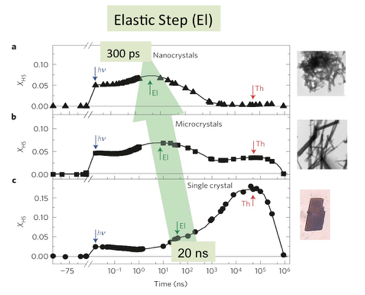
Dynamic characterizing the low-spin to high-spin transition triggered by a femtosecond laser pulse in [FeIII(3-MeOSalEen)2]PF6 in the form of single-crystal, micro- and nanocrystals
Elastically driven cooperative response of a molecular material impacted by a laser pulse. R. Bertoni, M. Lorenc, H. Cailleau, A. Tissot, J. Laisney, M-L. Boillot, L. Stoleriu, A. Stancu, C. Enachescu, E. Collet (2016) Nature Materials 15, 606–610
Une vague élastique pour amplifier la photo-commutation ultra-rapide de matériaux, http://www.cnrs.fr/inp/spip.php?article4521
Structural dynamics and coherence upon d-d vs MLCT light-induced spin state trapping
The photo-induced spin transition (LIESST effect), like the low-temperature photomagnetism, involves a ΔS = 2 spin change which due to the selection rules takes place by intersystem crossing involving intermediate excited states and the structural relaxation of metal-ligand bonds. Mechanism and ultrafast dynamics have been studied in FeIIN6 complexes under 1MLCT excitation. To compare several excitation pathways, we have designed a FeIIN4O2 spin-crossover material of lower symmetry whose d-d transitions may also be probed. By combining femtosecond optical absorption measurements, ab-initio DFT and TD-DFT calculations, we demonstrated that shorter intermediate states enhanced coherent structural dynamics and therefore 1d-d excitation induced faster low spin to high spin switching compared to MLCT.
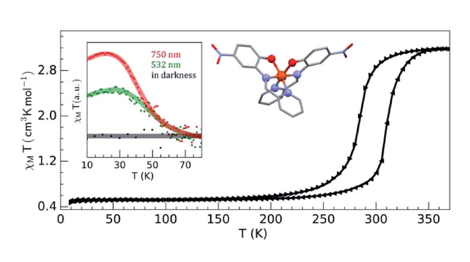
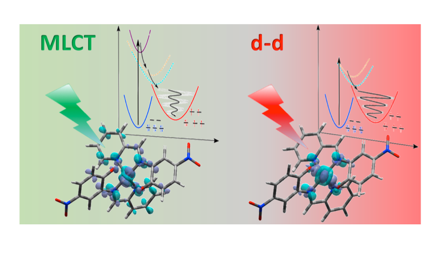
Spin transition and photomagnetism of FeII(pap-5NO2)2. Schematic view of the LIESST process showing that d-d excitation reduces the lifetime of intermediates compared to MLCT excitation, enhances the coherent structural dynamics and thus results in a faster low spin -to- high spin switching
Comparison of structural dynamics and coherence of d–d and MLCT light-induced spin state trapping. S. Zerdane, L. Wilbraham, M. Cammarata, O. Iasco, E. Rivière, M-L. Boillot, I. Ciofini, E. Collet (2017) Chem. Sci. 8, 4978-4986
Axis 3 - Molecular switching on surfaces
Self-assembled monolayer of molecules on gold surface : spin state switching detected by Scanning Tunneling Microscopy and studied by X ray absorption Spectroscopy
Spin-crossover molecules, whose spin states switch in response to an electric field and a light irradiation, are promising for spin electronics (or integration into electronic devices). However, it is mandatory to preserve the switchability on metallic surfaces at the scale of a few molecules (or single molecule), that is scarcely observed. This question was studied with T. Mallah, Scanning Tunneling Microscopy (STM) specialists (V. Repain, MPQ, Paris-Diderot Univ.) and theoreticians (C. Barreteau, CEA Paris-Saclay), the aim being to modulate the spin-polarized current by switching the magnetic moment of a spin-crossover molecule or vice versa. The formation of self-assembled monolayer of molecules on a gold surface was exploited to analyze by STM, a local technique, and theoretical calculations, the electronic structure of molecules, its change upon light irradiation and its dynamics. Moreover X-ray Magnetic Circular Dichroism and X-ray absorption spectroscopy measurements have provided evidences for the thermal spin-crossover and the presence of S = 2 iron(II) residue at low temperature. These observations rise the question of the importance of surface-molecules interactions with respect to the molecule-molecule interactions.
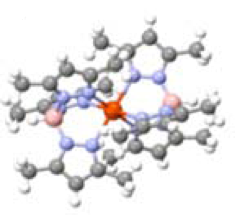
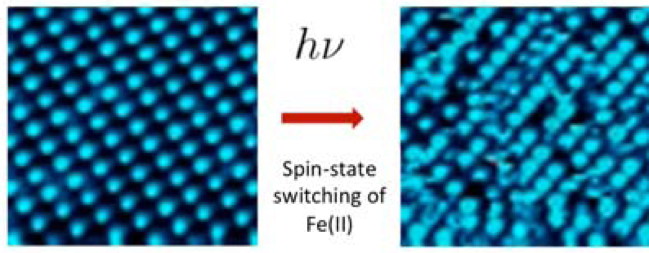
STM images (4.6 K) showing a self-assembled monolayer of Fe(HB(Me2pz)3)2 organized on a gold substrate before and after the blue light illumination
Molecular-scale dynamics of light-induced spin cross-over in a two-dimensional layer. K. Bairagi, O. Iasco, A. Bellec, A. Kartsev, D. Li, J. Lagoute, C. Chacon, Y. Girard, S. Rousset, F. Miserque, Y. Dappe, A. Smogunov, C. Barreteau, M-L. Boillot, T. Mallah, V. Repain (2016) Nature Communications 7, 12212
Temperature-, Light-, and Soft X-ray-Induced Spin Crossover in a Single Layer of FeII-Pyrazolylborate Molecules in Direct Contact with Gold. K. Bairagi, A. Bellec, C. Fourmental, O. Iasco, J. Lagoute, C. Chacon, Y. Girard, S. Rousset, F. Choueikani, E. Otero, Ph. Ohresser, Ph. Sainctavit, M-L. Boillot, T. Mallah, V. Repain (2018) J. Phys. Chem. C 122, 727–731
Contrôler des molécules magnétiques bistables auto-organisées avec de la lumière, http://www.cnrs.fr/inp/spip.php?article4747
PhD theses
Ongoing
Arthur Tauzin — Monolayers of switchable coordination compounds
PhD advisor : Marie-Laure Boillot (Started in october 2019)
Defended
Jérôme Laisney — Influence of the environement on the switching properties of spin transition micro- and nano- particles (2015)
PhD advisor : Marie-Laure Boillot
Luong Lam Nguyen — Nanoparticles of molecular photoswitches based on spin-croossover Fe(II) complexes with photoisomerizable ligands (2014)
PhD advisor : Marie-Laure Boillot
Last publications (2016 - Today)
Investigation of the spin crossover behaviour of a sublimable Fe(ii)-qsal complex: from the bulk to a submonolayer on graphene/SiO2. A. Trapali, M. Muppal, S. Pandey, M.-L. Boillot, V. Repain, Y. J. Dappe, J.-F. Dayen, E. Rivière, R. Guillot, M.-A. Arrio, E. Otero, A. Bellec, T. Mallah, Dalton Trans., 2024, 53, 12519-12526
Optical Read-Out of the Electrical Switching of Cobalt-Terpyridine-BODIPY Molecules Immobilized as Single Layer on ITO. K. Magra, J.-F. Audibert, D. Dragoe, T. Mallah, F. Miomandre, M.-L. Boillot, Advanced Optical Materials, 2023, 11, 2301128
Mechanoelastic simulations of monolayer lattices of spin crossover molecules on a substrate. A. Railean, M. Kelai, A. Bellec, V. Repain, M.-L. Boillot, T. Mallah, L. Stoleriu, C. Enachescu, Physical Review B, 2023, 107, 014304
Interface versus Bulk Light-Induced Switching in Spin-Crossover Molecular Ultrathin Films Adsorbed on a Metallic Surface. M. Kelai, A. Tauzin, A. Railean, V. Repain, J. Lagoute, Y. Girard, S. Rousset, E. Otero, T. Mallah, M.-L. Boillot, C. Enachescu, A. Bellec, J. Phys. Chem. Lett., 2023, 14, 1949-1954
Molecular Magnetic Materials Based on {CoIII(Tp*)(CN)3}− Cyanidometallate: Combined Magnetic, Structural and 59Co NMR Study. S. De, A. Flambard, B. Xu, L.-M. Chamoreau, G. Gontard, L. Lisnard, Y. Li, M.-L. Boillot, R. Lescouëzec, Chemistry – A European Journal, 2022, 28, e202200783
Dynamical limits for the molecular switching in a photoexcited material revealed by X-ray diffraction. A. Volte, C. Mariette, R. Bertoni, M. Cammarata, X. Dong, E. Trzop, H. Cailleau, E. Collet, M. Levantino, M. Wulff, J. Kubicki, F.-L. Yang, M.-L. Boillot, B. Corraze, L. Stoleriu, C. Enachescu, M. Lorenc, Communications Physics, 2022, 5, 168
Robust magnetic anisotropy of a monolayer of hexacoordinate Fe(ii) complexes assembled on Cu(111). M. Kelai, B. Cahier, M. Atanasov, F. Neese, Y. Tong, L. Zhang, A. Bellec, O. Iasco, E. Rivière, R. Guillot, C. Chacon, Y. Girard, J. Lagoute, S. Rousset, V. Repain, E. Otero, M.-A. Arrio, P. Sainctavit, A.-L. Barra, M.-L. Boillot, T. Mallah, Inorg. Chem. Front., 2021, 8, 2395-2404
Voltage-Induced Bistability of Single Spin-Crossover Molecules in a Two-Dimensional Monolayer. Y. Tong, M. Kelaï, K. Bairagi, V. Repain, J. Lagoute, Y. Girard, S. Rousset, M.-L. Boillot, T. Mallah, C. Enachescu, A. Bellec, J. Phys. Chem. Lett., 2021, 12, 11029-11034
Building responsive materials by assembling Fe4Co4 switchable molecular cubes. Q. P. Xuan, J. Glatz, A. Benchohra, J.-R. Jiménez, R. Plamont, L.-M. Chamoreau, A. Flambard, Y. Li, L. Lisnard, D. Dambournet, O. J. Borkiewicz, M.-L. Boillot, L. Catala, A. Tissot, R. Lescouëzec, J. Mater. Chem. C, 2021, 9, 8882-8890
Unexpected Light-Induced Thermal Hysteresis in Matrix Embedded Low Cooperative Spin Crossover Microparticles. D. Plesca, A. Railean, R. Tanasa, A. Stancu, J. Laisney, M.-L. Boillot, C. Enachescu, Magnetochemistry, 2021, 7, 59
Thermal Bistability of an Ultrathin Film of Iron(II) Spin-Crossover Molecules Directly Adsorbed on a Metal Surface. M. Kelai, V. Repain, A. Tauzin, W. Li, Y. Girard, J. Lagoute, S. Rousset, E. Otero, P. Sainctavit, M.-A. Arrio, M.-L. Boillot, T. Mallah, C. Enachescu, A. Bellec, J. Phys. Chem. Lett., 2021, 12, 6152-6158
Electrical read-out of light-induced spin transition in thin film spin crossover/graphene heterostructures. N. Konstantinov, A. Tauzin, U. N. Noumbé, D. Dragoe, B. Kundys, H. Majjad, A. Brosseau, M. Lenertz, A. Singh, S. Berciaud, M.-L. Boillot, B. Doudin, T. Mallah, J.-F. Dayen, J. Mater. Chem. C, 2021, 9, 2712-2720
Anomalous Light-Induced Spin-State Switching for Iron(II) Spin-Crossover Molecules in Direct Contact with Metal Surfaces. L. Zhang, Y. Tong, M. Kelai, A. Bellec, J. Lagoute, C. Chacon, Y. Girard, S. Rousset, M.-L. Boillot, E. Rivière, T. Mallah, E. Otero, M.-A. Arrio, P. Sainctavit, V. Repain, Angewandte Chemie International Edition, 2020, 59, 13341-13346
Mechanical-tuning of the cooperativity of SC particles via the matrix crystallization and related size effects. J. Laisney, D. Morineau, C. Enachescu, R. Tanasa, E. Riviere, R. Guillot, M.-L. Boillot, J. Mater. Chem. C, 2020, 8, 7067-7078
Photoselective MLCT to d-d pathways for light-induced excited spin state trapping. S. Zerdane, M. Cammarata, O. Iasco, M.-L. Boillot, E. Collet, J. Chem. Phys., 2019, 151, 171101
Importance of Epitaxial Strain at a Spin-Crossover Molecule–Metal Interface. C. Fourmental, S. Mondal, R. Banerjee, A. Bellec, Y. Garreau, A. Coati, C. Chacon, Y. Girard, J. Lagoute, S. Rousset, M.-L. Boillot, T. Mallah, C. Enachescu, C. Barreteau, Y. J. Dappe, A. Smogunov, S. Narasimhan, V. Repain, J. Phys. Chem. Lett., 2019, 4103-4109
Unraveling the Environment Influence in Bistable Spin-Crossover Particles Using Magnetometric and Calorimetric First-Order Reverse Curves. R. Tanasa, C. Enachescu, J. Laisney, D. Morineau, A. Stancu, M.-L. Boillot, J. Phys. Chem. C, 2019, 123, 10120-10129
Temperature dependence of the cooperative out-of-equilibrium elastic switching in a spin-crossover material. R. Bertoni, E. Collet, H. Cailleau, M.-L. Boillot, A. Tissot, J. Laisney, C. Enachescu, M. Lorenc, Phys. Chem. Chem. Phys., 2019, 21, 6606-6612
Mononuclear ferrous and ferric complexes. M.-L. Boillot, B. Weber, Comptes Rendus Chimie, 2018, 21, 1196-1208
Thermally-Induced Spin Crossover and LIESST Effect in the Neutral [FeII(Mebik)2(NCX)2] Complexes: Variable-Temperature Structural, Magnetic, and Optical Studies (X = S, Se; Mebik = bis(1-methylimidazol-2-yl)ketone). S. De, L.-M. Chamoreau, H. El Said, Y. Li, A. Flambard, M.-L. Boillot, S. Tewary, G. Rajaraman, R. Lescouëzec, Frontiers in Chemistry, 2018, 6, 326
Pressure-induced switching properties of the iron(III) spin transition complex [FeIII(3-OMeSalEen)2]PF6. J. Laisney, H. J. Shepherd, L. Rechignat, G. Molnar, E. Rivière, M.-L. Boillot, Physical Chemistry Chemical Physics, 2018, 20, 15951-15959
Solution and Solid-State Study of the Spin-Crossover [FeII(R-bik)3](BF4)2 Complexes (R = Me, Et, Vinyl). S. De, S. Tewary, D. Garnier, Y. Li, G. Gontard, L. Lisnard, A. Flambard, F. Breher, M.-L. Boillot, G. Rajaraman, R. Lescouëzec, European Journal of Inorganic Chemistry, 2018, 2018, 414-428
Temperature-, Light-, and Soft X-ray-Induced Spin Crossover in a Single Layer of FeII-Pyrazolylborate Molecules in Direct Contact with Gold. K. Bairagi, A. Bellec, C. Fourmental, O. Iasco, J. Lagoute, C. Chacon, Y. Girard, S. Rousset, F. Choueikani, E. Otero, P. Ohresser, P. Sainctavit, M.-L. Boillot, T. Mallah, V. Repain, J. Phys. Chem. C, 2018, 122, 727-731
The disentangling of hysteretic spin transition, polymorphism and metastability in bistable thin films formed by sublimation of bis(scorpionate) Fe(ii) molecules. O. Iasco, M.-L. Boillot, A. Bellec, R. Guillot, E. Riviere, S. Mazerat, S. Nowak, D. Morineau, A. Brosseau, F. Miserque, V. Repain, T. Mallah, J. Mater. Chem. C, 2017, 5, 11067-11075
Comparison of structural dynamics and coherence of d-d and MLCT light-induced spin state trapping. S. Zerdane, L. Wilbraham, M. Cammarata, O. Iasco, E. Riviere, M.-L. Boillot, I. Ciofini, E. Collet, Chem. Sci., 2017, 8, 4978-4986
Molecular-scale dynamics of light-induced spin cross-over in a two-dimensional layer. K. Bairagi, O. Iasco, A. Bellec, A. Kartsev, D. Li, J. Lagoute, C. Chacon, Y. Girard, S. Rousset, F. Miserque, Y. J. Dappe, A. Smogunov, C. Barreteau, M.-L. Boillot, T. Mallah, V. Repain, Nat Commun, 2016, 7, 12212
Matrix-assisted relaxation in Fe(phen)2(NCS)2 spin-crossover microparticles, experimental and theoretical investigations. C. Enachescu, R. Tanasa, A. Stancu, A. Tissot, J. Laisney, M.-L. Boillot, Applied Physics Letters, 2016, 109, 031908
Elastically driven cooperative response of a molecular material impacted by a laser pulse. R. Bertoni, M. Lorenc, H. Cailleau, A. Tissot, J. Laisney, M.-L. Boillot, L. Stoleriu, A. Stancu, C. Enachescu, E. Collet, Nature Materials, 2016, 15, 606-610
Last update on Feb. 28th 2022
